Here’s the Giro d’Italia guide. You’ll find all the stage profiles together on one page and summary of each stage.
There’s also all the rules in case you need to know time cuts and how the points and mountains competitions work.
As ever you can read this post but there is a permanent page all May at inrng.com/giro which can also be found via the menu at the top.
Route summary
In one word: gentler. It’s shorter as the average stage length is 173km, down 20km from last year. It’s flatter, with about 44,000m of vertical gain which means 8,000m (15%) less than 2023, the least amount since 2010. If there are six summit finishes some of these are “big ring” types of climbs.
Two time trials totalling 70km make the overall win tricky for pure climbers and there could be up to nine bunch sprints.

Stage 1 – Saturday 4 May – 1850m V+

An gentler Giro but no soft start. This is a short, crunchy stage and possibly the chance for Tadej Pogačar to take the maglia rosa… and keep it to Rome. A feat not achieved since Gianni Bugno in 1990 but would it be wise to try? The stage win, yes but defending the lead in the coming days is another matter. He’ll find plenty of rivals at least for the win in Torino.
Stage 2 – Sunday 5 May – 2300m V+

A scenic ride via the “Zegna Oasis”, a park created by the eponymous fashion designer. The Oropa summit finish is no walk in the park, listed as 11.8km at 6.2%, this includes the easy roads out of Biella that lead to a fierce 7km section that almost never goes below 8% as it winds up through the woodland with steep hairpins, this is a big day for the GC contenders.
Stage 3 – Monday 6 May – 750m V+
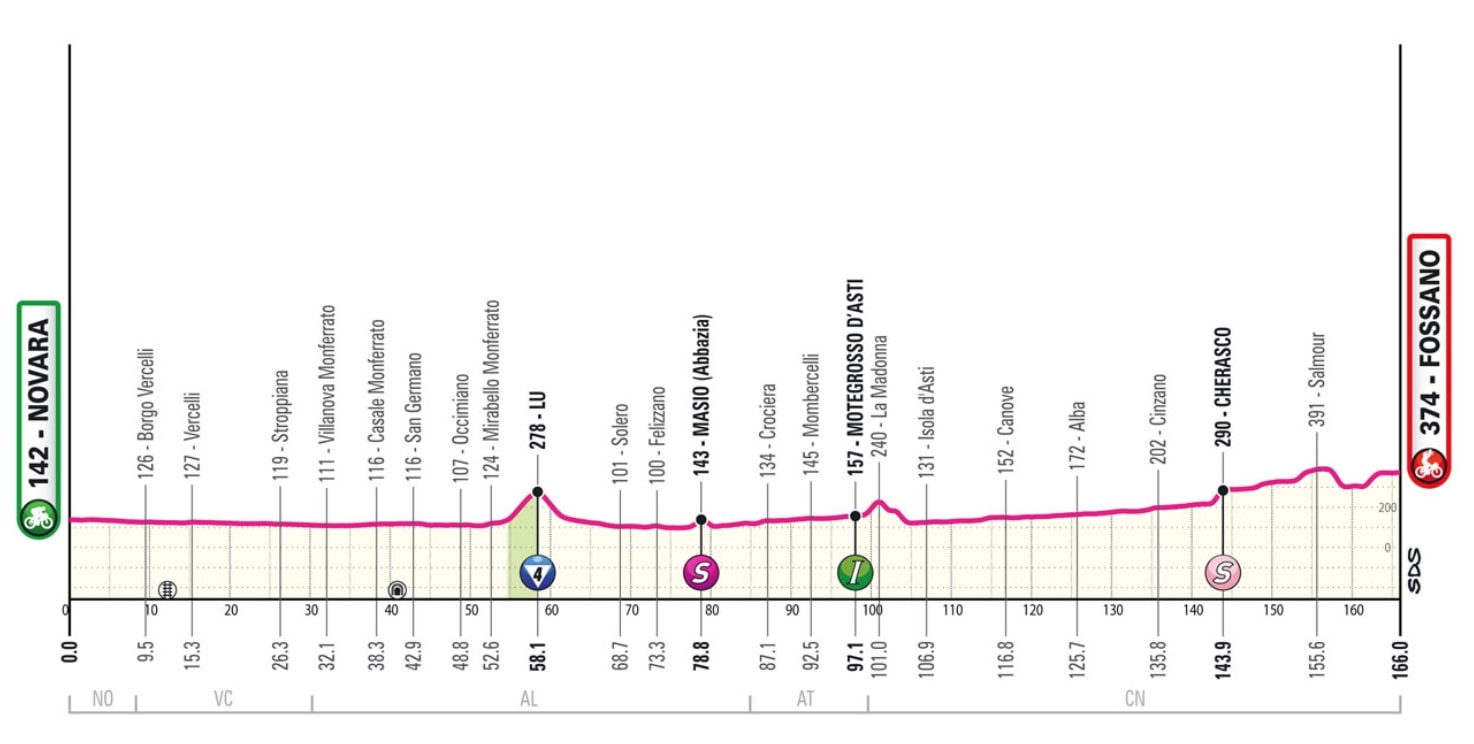
Monday and a sprint stage as the race crosses the plains. There’s more food and wine than sport as it passes risotto rice fields and plenty of vineyards before the climb to Fossano which could sour things for the sprinters.
Stage 4 – Tuesday 7 May – 1700m V+

A start in Acqui Terme, famous for its “boiling spring” that has gushed out steaming water since Roman days but the race won’t reach boiling point until late as it crosses over the Ligurian hills to the Mediterranean and then takes up the Milan-Sanremo. Like the previous day a short climb, this time the Capo Mele, the easiest of the capi triology, is there to disrupt sprint trains before the finish.
Stage 5 – Wednesday 8 May – 1700m V+

After the previous day’s Milan-Sanremo déjà vu, more familiar roads with the Passo del Bracco, this time taken in the opposite direction to the 2023 Giro and then a finish in Lucca in one of the regional heartlands of Italian cycling and here the Montemagno climb is gentle. This is the third sprint stage in a row.
Stage 6 – Thursday 9 May – 1900m V+
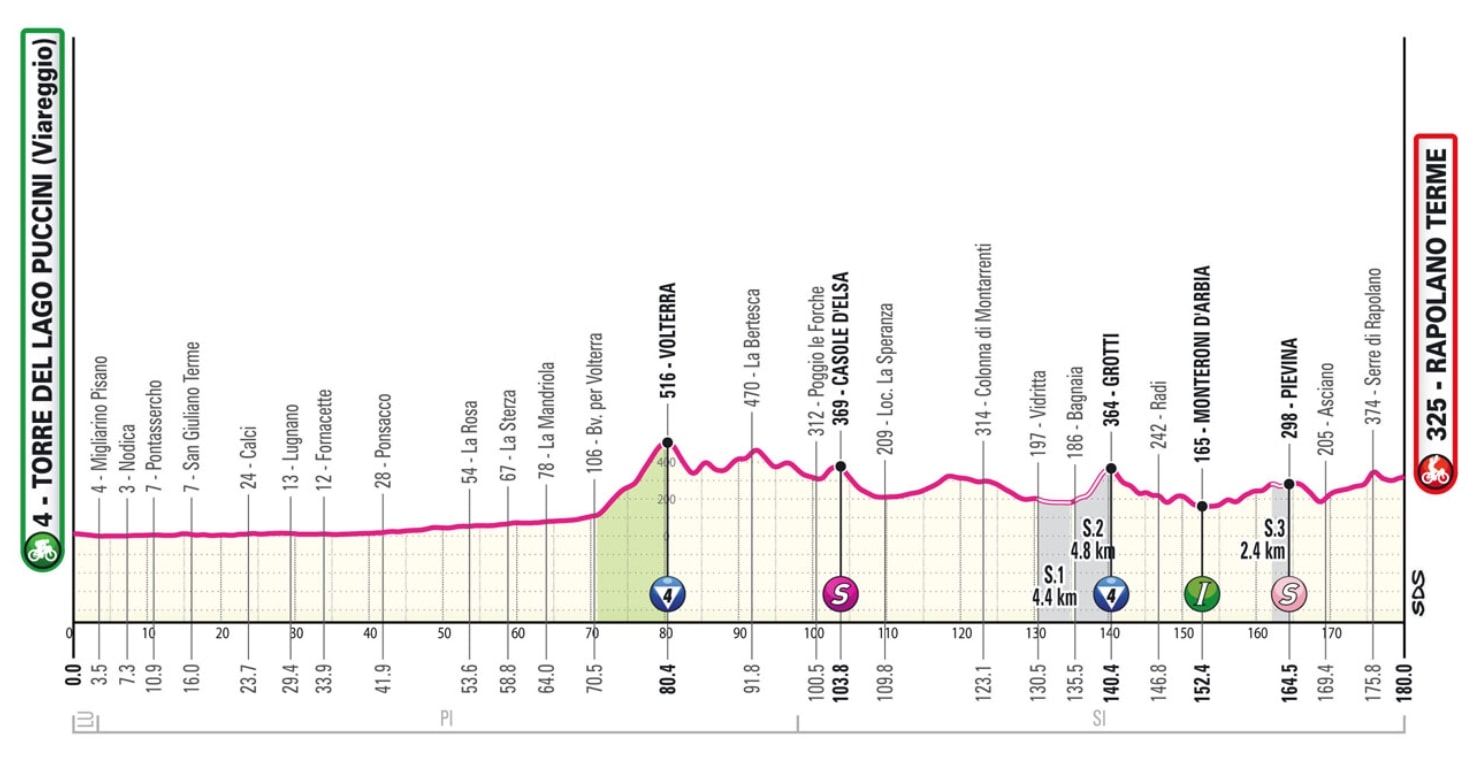
The sterrato or strade bianche stage with three sections totalling 11.6km to the south of Siena. It’s a more gentle day than the Giro’s 2021 stage to Montalcino but there’s still 1,900m of vertical gain here, and packed in the second half. The gravel gets the headlines but there are plenty of twisty tarmac roads with steep ramps to make the going hard too.
Stage 7 – Friday 10 May – 400m V+

The first time trial stage and the profile says it all, flat for 34km before the climb to Perugia including some steep parts. Two time trial stages in this race are an invitation to hulking homeland hero Filippo Ganna.
Stage 8 – Saturday 11 May – 3750m V+

A hard day, a real mountain stage. An unmarked but very real climb out of Spoleto will help the breakaway go clear. Prato di Tivo’s been a regular in Tirreno-Adriatico, eg 2021, and hosts the second summit finish of the Giro. It’s a long climb on a wide road, a ski station summit finish but with a wild feel as it’s remote. Once again near the Gran Sasso, RCS will be praying there’s no headwind so as to avoid last year’s anticlimactic outcome at nearby Campo Imperatore.
Stage 9 – Sunday 12 May – 1300m V+
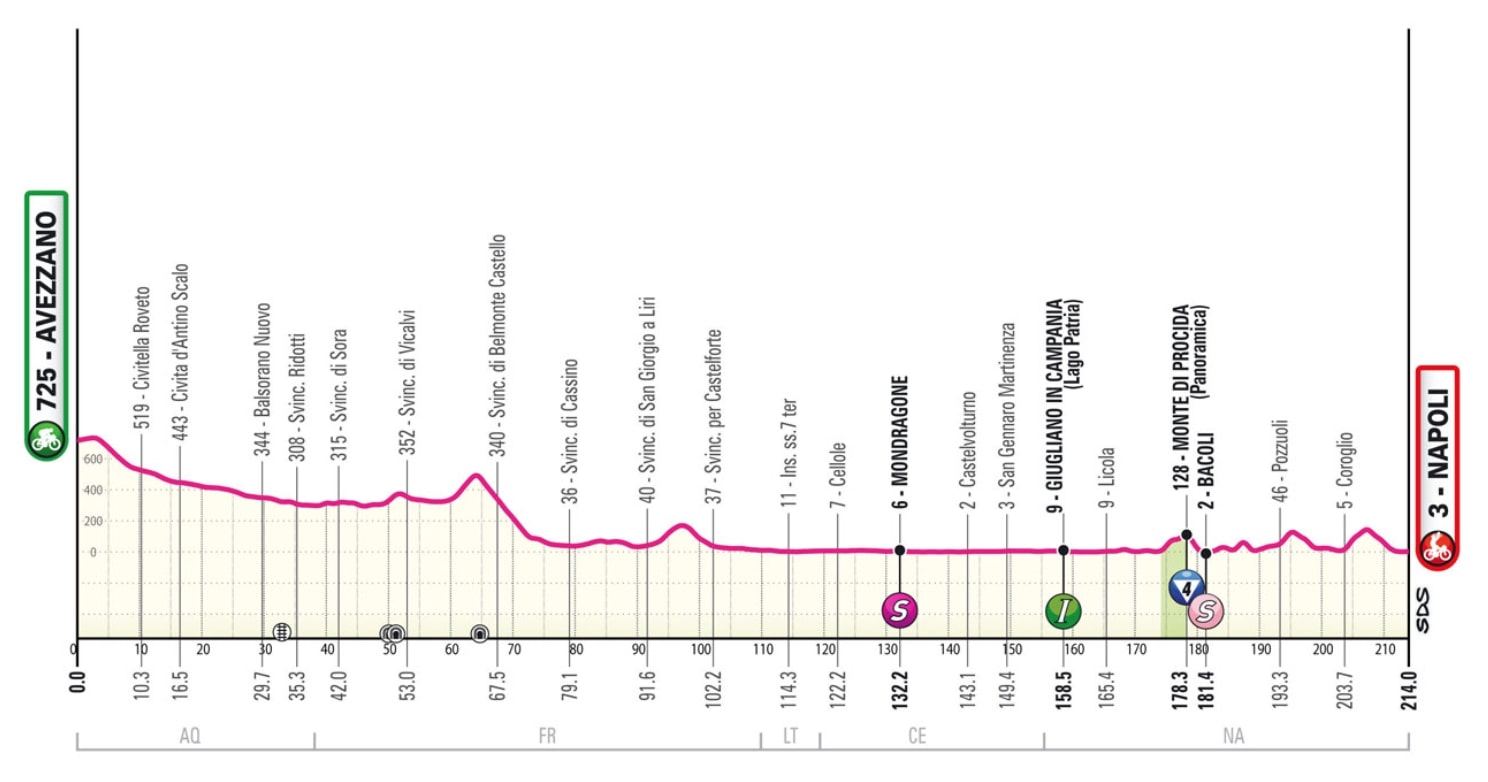
The Giro is back to Napoli for the third year in a row and this time a possible sprint finish but with some tricky roads in the finale, this is no dragster finish. First via the volcanic campi flegrei – said to be more risky than Vesuvius for a disastrous eruption – then into the urban streets where the peloton has its own risk. At 206km it’s the longest stage of the opening week.
Stage 10 – Tuesday 14 May – 2850m V+

A start in Pompeii and the Giro reaches its southernmost point for the three weeks before heading north into the Matese hills and a summit finish on the Bocca della Selva, a long climb but rarely steep, a big ring kind of climb or what is called pedalabile, “pedalable” in Italian, and a probable breakaway day but only 141km.
Stage 11 – Wednesday 15 May – 1850m V+

A sprint stage on the coast.
Stage 12 – Thursday 16 May – 2100m V+
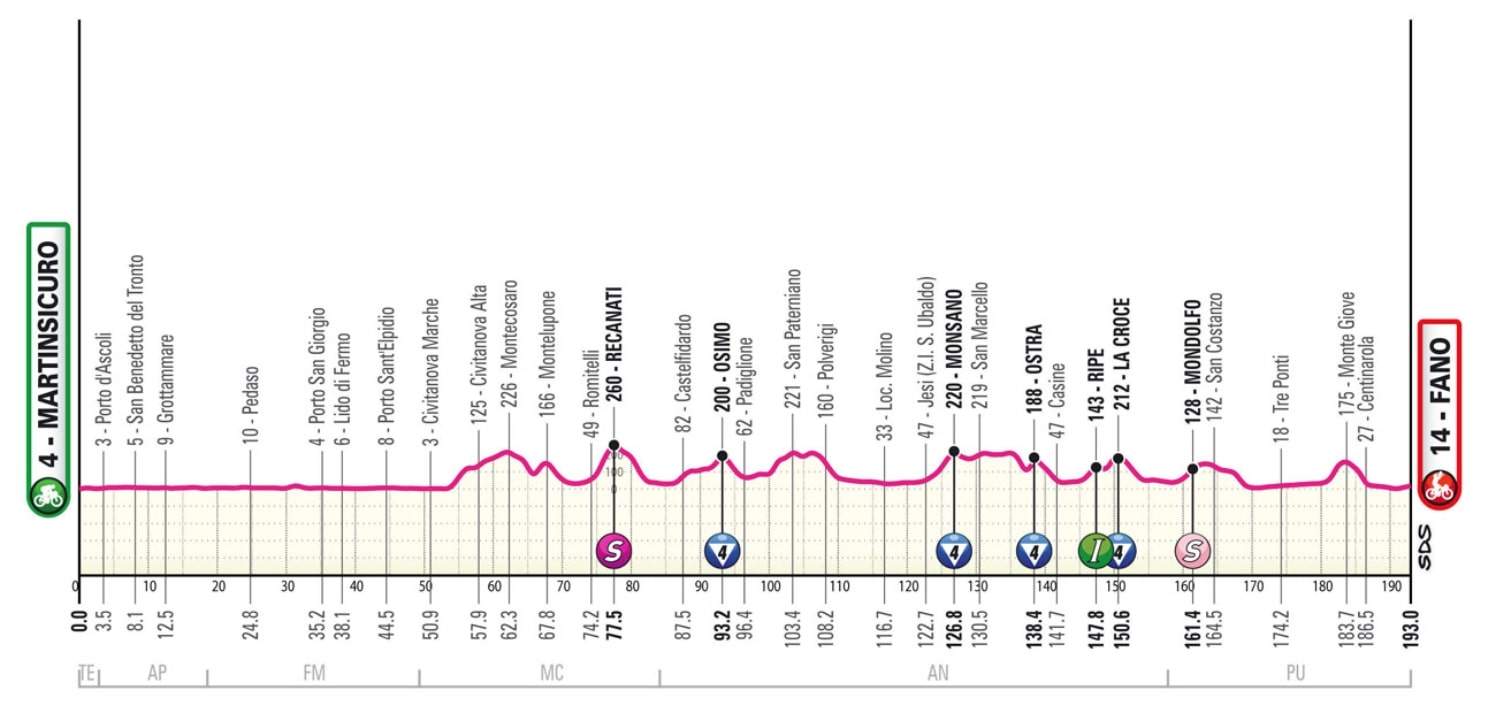
A fun stage with some of the “wall” climbs from Tirreno-Adriatico, but none of the wildest ramps. There are six categorised climbs and more unmarked ones.
Stage 13 – Friday 17 May – 150m V+
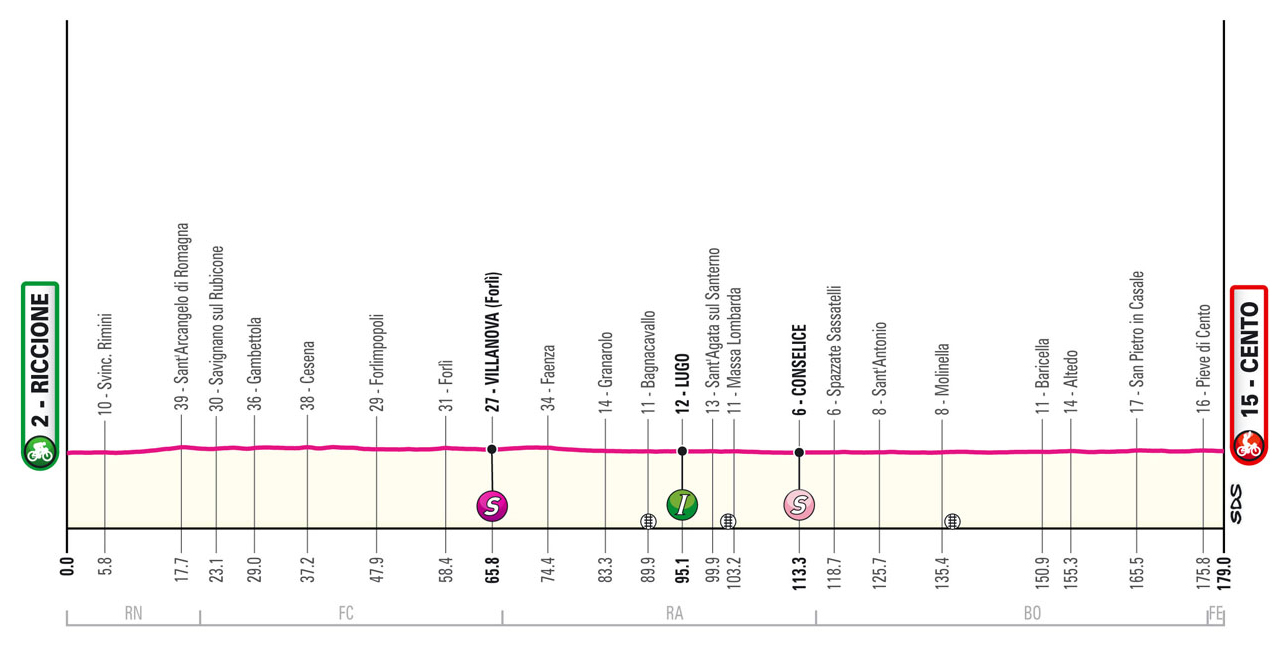
A sprint stage.
Stage 14 – Saturday 18 May – 100m V+
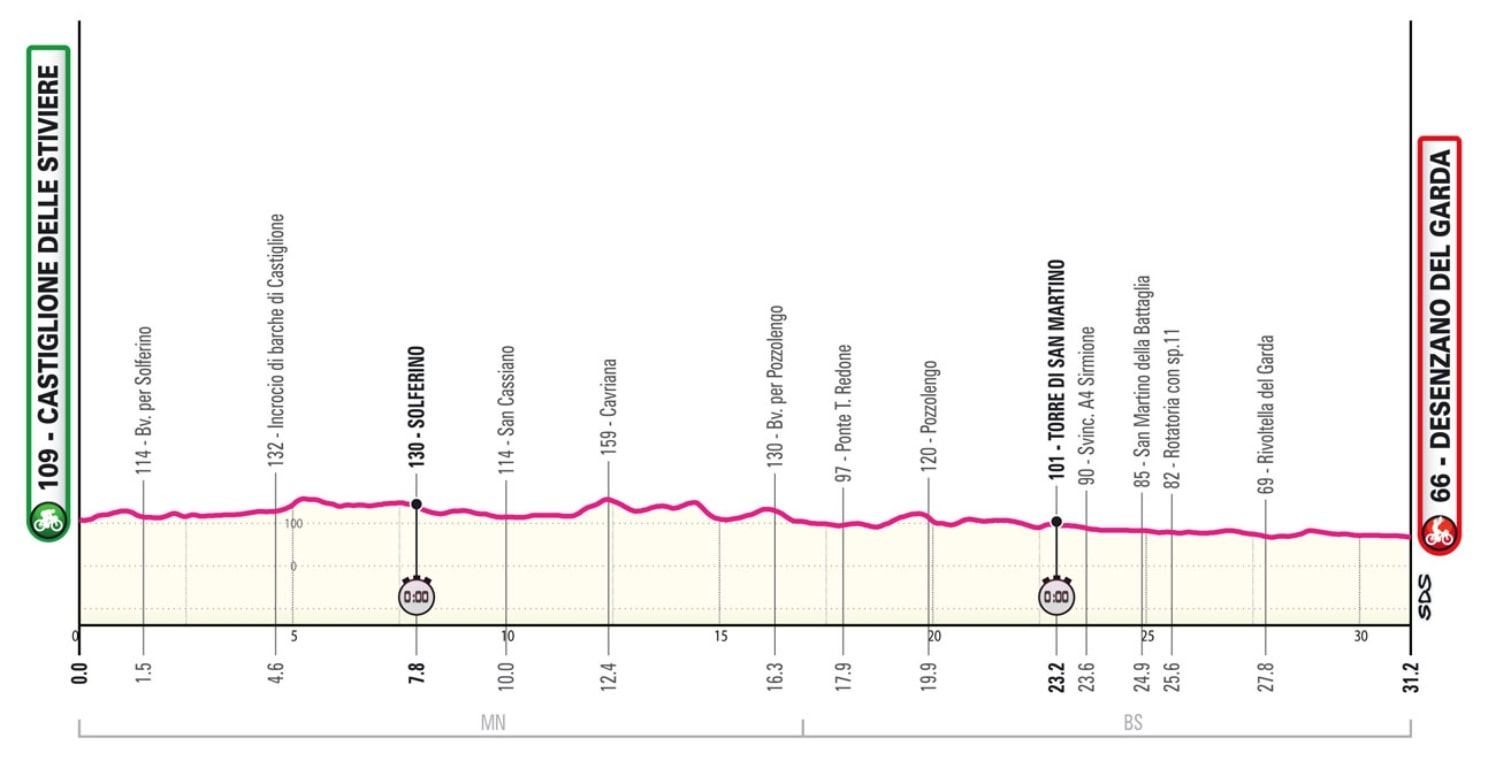
The second time trial stage and flat. It’s on rural, twisting roads where a good line saves seconds.
Stage 15 – Sunday 19 May – 5250m V+
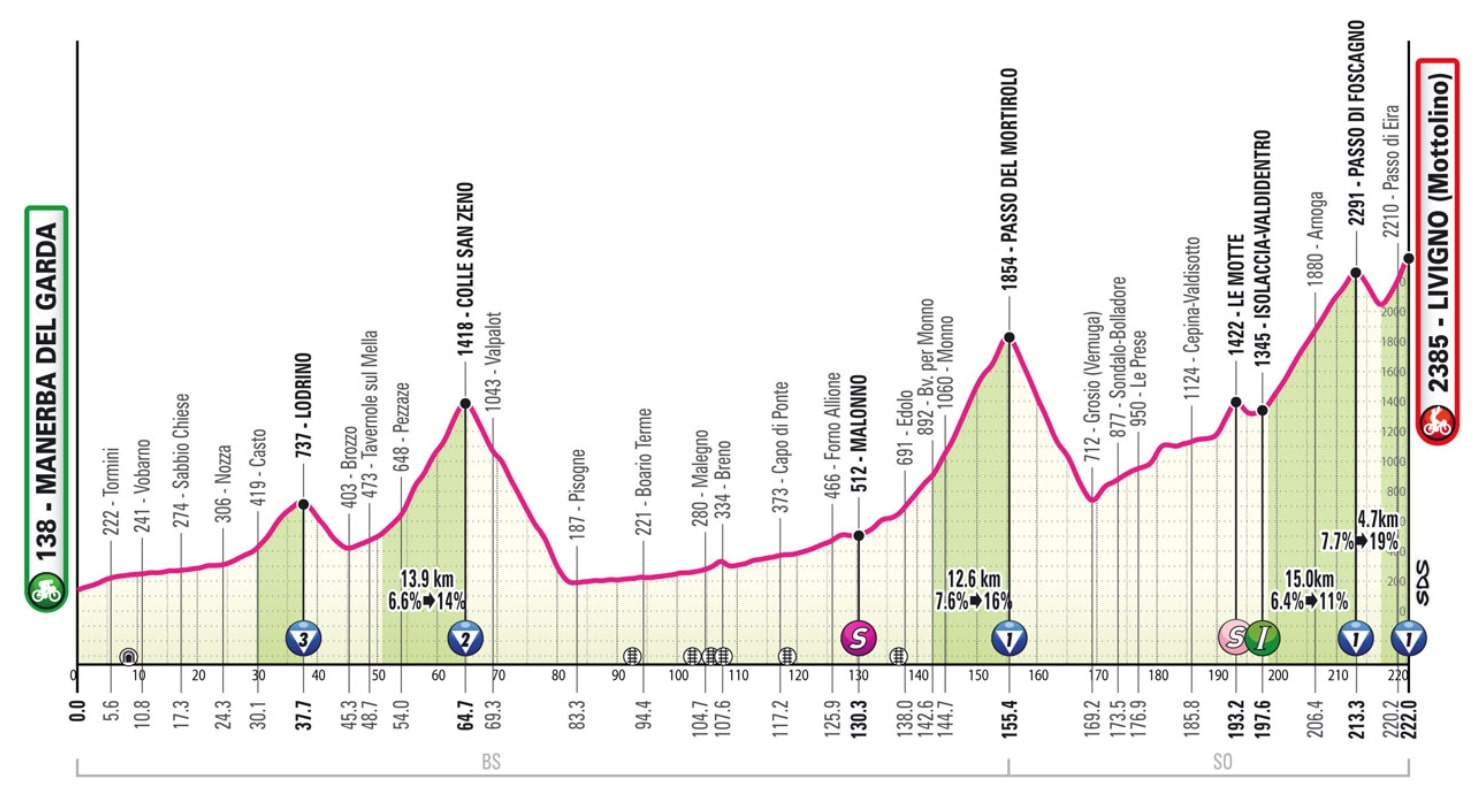
The tappone. In a Giro of shortened stages this is the longest stage of the race. A 220km marathon and over 5,000m of vertical gain. The Mortirolo is mid-stage and if it’s climbed by the easy side that means they descend the trickiest slopes. Mottolino, not so much a ski resort as a ski piste, for the 2026 Winter Olympics in Livigno. It’s via the main road to the Passo Eira, then a turn onto a small service road with sections from 9-17%. As a one way road up, the rest day after is planned to allow more time to get the race infrastructure down the mountain.
Stage 16 – Tuesday 21 May – 4350m V+

Two mountain passes but no points then Stelvio from Bormio and the Cima Coppi high point, a big day for the mountains competition as it’s in the stage and the springboard for a breakaway. Then a long procession into South Tyrol and Italy’s German-speaking corner ending in a summit finish above Ortisei with gentler gradients to start before 3km at over 10% on the Panastraße.
Stage 17 – Wednesday 22 May – 4100m V+
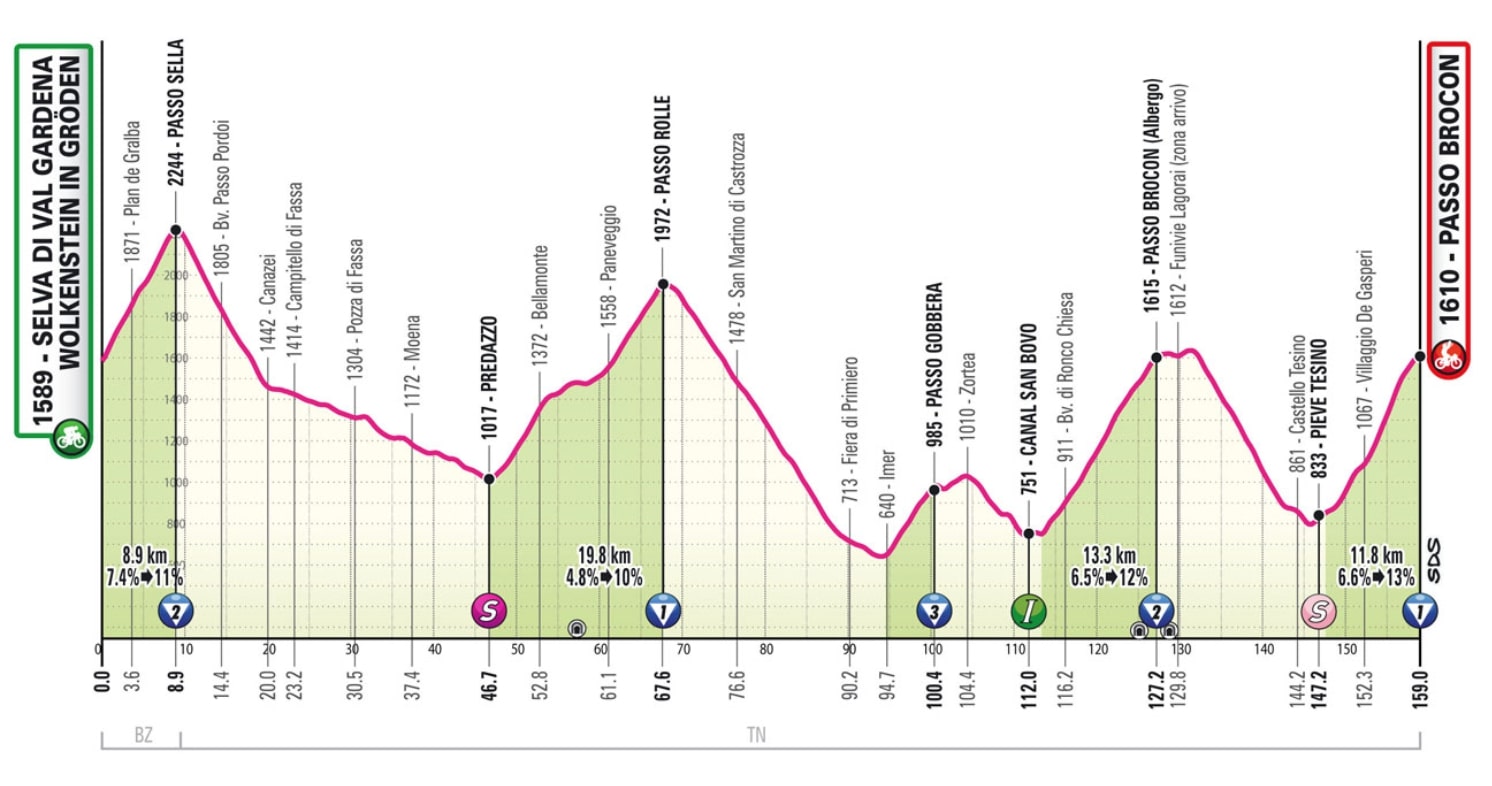
If stage 15 was the tappone, this is another claim to royalty. The Dolomites and 4,100m of climbing compressed into 159km with the famous Selva and Rolle passes before the “new” Passo Brocon, climbed here twice: once from the north then a descent to the south before climbing back up another version of the southern flank. The stats on the profile say the first time is easier but the second time up is more uneven and has some steeper parts. Neither side is savage but combined they’ll be selective.
Stage 18 – Thursday 23 May – 550m V+
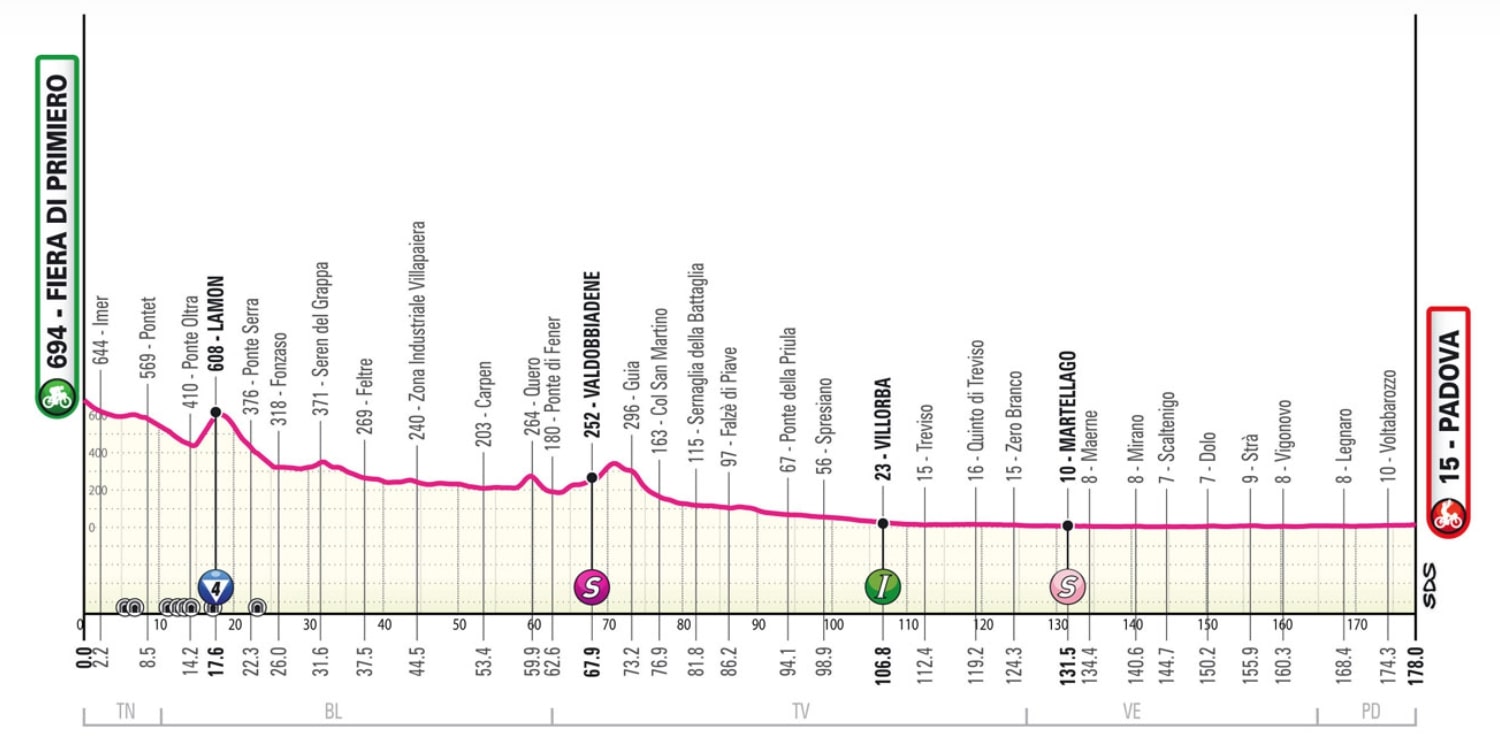
A sprint stage as the race exits the mountains via the prosecco vineyards. Arguably more importantly it’s an active rest day for the GC contenders who can recover a bit for the upcoming days. Watch out for the corners in the finish through Padova.
Stage 19 – Friday 24 May – 2850m V+

A day for the breakaway? Surely that’s the base case on a stage with 2,700m that’s open to many types of rider but it’s also ambush territory on the off-chance a rider has a slender lead and a rival with a strong team wants to hammer things.
Stage 20 – Saturday 25 May – 4250m V+
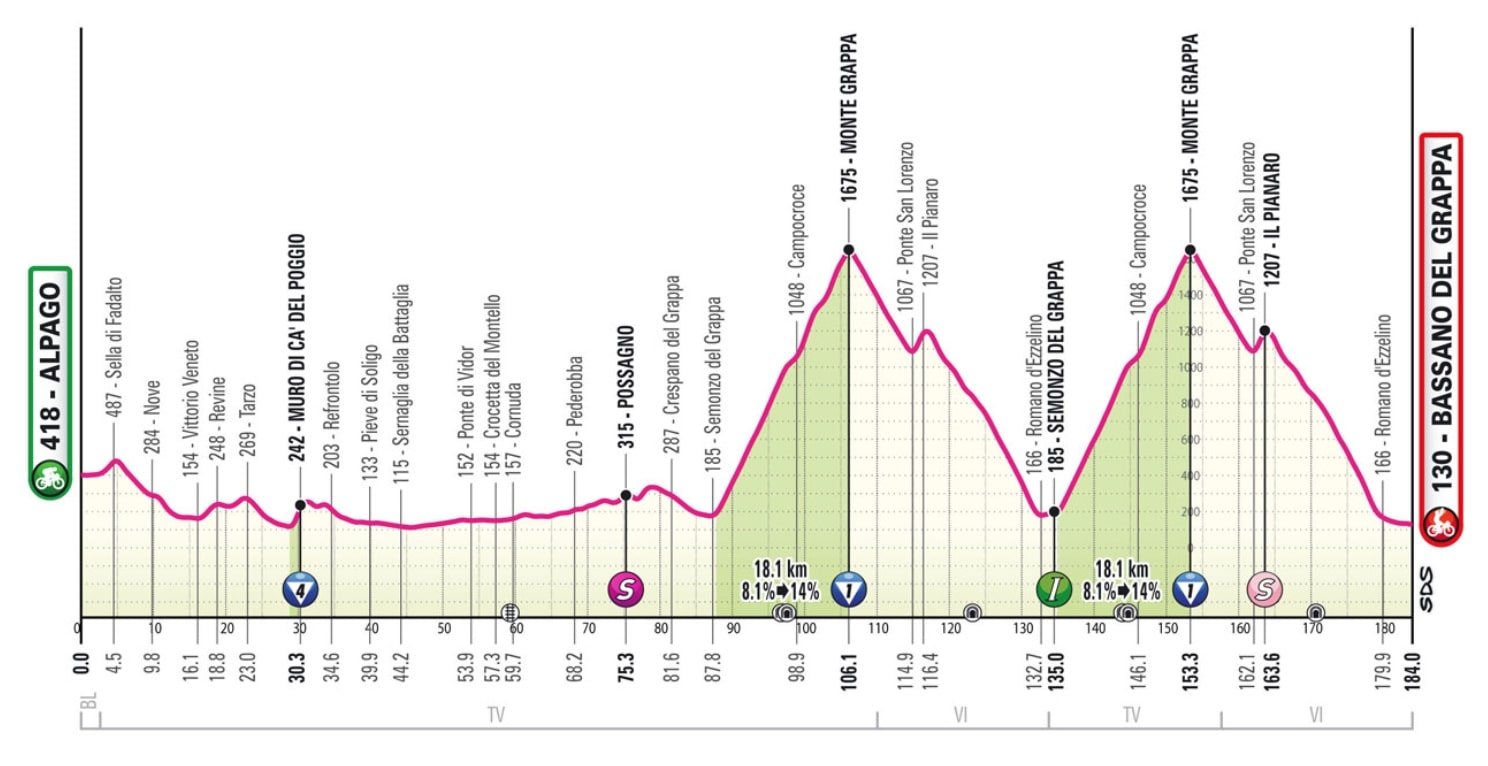
Two ascents of Monte Grappa, 18km at an average of 8.1% is tough but that’s with two brief downhills on the way so it’s more often 9% and more, especially on the upper slopes. The descents matter as much as the climbs, tricky in places.
Stage 21 – Sunday 26 May – 300m V+

A copycat stage of last year’s finish with a start in the Eur district and then the Rome criterium finish.
The Jerseys

There are four jerseys in the race: pink, cyclamen, blue and white.
Pink: the most famous one, the maglia rosa, it is awarded to the rider with the shortest overall time for all the stages added together. As such, they have covered the course faster than anyone else. It is pink because the race has been organised by La Gazzetta Dello Sport, a newspaper printed on bright pink paper. It is sponsored by Enel, an energy company.
There are time bonuses available on all the stages except the time trials:
- 10-6-4 seconds for the first three riders respectively on each stage
- 3-2-1 seconds at second intermediate sprint of the day
- 3-2-1 seconds at “Intergiro” point, look for the “I” in a green circle on the stage profiles
Cyclamen: the points competition. Riders score points at both of the intermediate sprints per day and at the finish line. The allocation of points depends on the stage in question, they are categorised with the typical sprint stages offering more points in a bid to place the purple-toned jersey on the shoulders of a sprinter who can handle arithmetic. The maglia ciclamino is sponsored by Be It, a Made in Italy marketing campaign.
-
- Category A+B stages (Stages 3,4,5,9,11,13,18,21) offer points for the first 15 riders at the finish: 50-35-25-18-14-12-10-8-7-6-5-4-3-2-1
- Category C stages: (Stages 1,6,12) offer points for the first 10: 25-18-12-8-6-5-4-3-2-1
- Category D+E: (Stages 2,7,8,10,14,15,16,17,19,20) offer points for the first 10: 15-12-9-7-6-5-4-3-2-1
- For the first intermediate sprint of each stage there are points for the first eight: 12-8-6-5-4-3-2-1
- At the Intergiro sprint also 12-8-6-5-4-3-2-1
- (in case you are wondering the second intermediate sprint counts for the “flying sprint” competition, both intermediate points also offer 10,6,3,2,1 points for a separate competition
Blue: the mountains jersey. It is sponsored by Banca Mediolanum, a bank. There are five categories of climb:
- 13 fourth category climbs: the first three riders crossing the top of the climb win 3-2 and 1 points respectively
- 10 third category climbs: the first four riders over the top get 9-4-2-1 points
- 9 second category climbs: first six riders get 18-8-6-4-2-1 points but if it is also the finish of the stage then 26, 12, 8, 4, 2, 1 points instead
- 11 first category climbs: the first eight riders get 40-18-12-9-6-4-2-1 points but if it is also the stage finish then 50,24,16,9,6,4,2,1
- CC or Cima Coppi: a special award, the “Coppi Summit” for the highest point of the race. This year it is the Stelvio on Stage 16. The first nine win 50-30-20-14-10-6-4-2-1 points
White: for the best young rider, this is awarded on the same basis as the pink jersey, except the rider must be born after 1 January 1999, ie aged 25 or under. It is sponsored by Eataly, a restaurant and food retail company.
Now a rider can’t wear two jerseys at once, they’d get too hot and the sponsors wouldn’t get the exposure they’ve paid for. So if a rider leads several classifications, they take the most prestigious jersey for themselves and the number-two ranked rider in the other competition gets to wear the other jersey. For example if a rider has both the pink jersey and the blue mountains jersey they’ll wear pink whilst whoever is second in the mountains jersey will sport blue jersey. The hierarchy is pink > points > mountains > white.
There are also other prizes and in-race competitions such as the intermediate sprint competition which is separate to the points competition or the time bonuses also available at these spots; the breakaway prize for the rider with the most kilometres in the breakaway; the fighting spirit prize which is a combined competition for scoring across the points, mountains and so on; the team prize; and the fair play prize for teams that avoid fines and penalties.
Time cuts
All riders have to make the time cut each day to stay in the race and this is a function of the stage type and average speed:
- Stages 3,13,18,21: the winner’s time plus 7% if the average speed is less than or equal to 40 km/h; 8% of the average speed is between 40 and 45 km/h; 10% if the average speed is over 45 km/h
- Stages 4,5,9,11: the winner’s time plus 9% if the average speed is less than or equal to 37 km/h; 10% of the average speed is between 37 and 41 km/h; 11% if the average speed is over 41 km/h
- Stages 1,6,12: the winner’s time plus 11% if the average speed is less than or equal to 35 km/h; 12% if the average speed is between 35 km and 39 km/h; 13% if the average speed is over 39 km/h
- Stages 2,8,10,17,19: the winners’ time plus 19% if the average speed is less than or equal to 30 km/h; 21% if the average speed between 30 km/h and 34 km/h; 22% if the average speed is over 34km/h;
- Stages 15,16,20: the winners’ time plus 16% if the average speed is less than or equal to 30 km/h; 17% if the average speed between 30 km/h and 34 km/h; 18% if the average speed is over 34km/h;
- For TT Stages, the winner’s time plus 30%
Three Kilometre Rule
Anyone with a mechanical or crash within the final three kilometres can get the same finishing time as the group the were with at the time of the incident on Stages 1,3,4,5,6,9,11,12,13,18,20 and 21.
Bunch sprint time gaps
The protocol for time gaps in bunch sprints applies for Stages 3,4,5,9,11,13,18 and 21.
The unmissable stages
Anything can happen during the Giro but there are some stages that matter more than others, some suggestions for the must-watch days:
- Stage 2: the Oropa summit finish
- Stage 10: a short stage that suits the breakaway so look for non-stop action
- Stage 12: the “walls” of the Marche region
- Stage 15: the hardest stage with the finish above Livigno
- Stage 17: a hard day in the Dolomites
- Stage 20: Monte Grappa and the final mountain stage

TV
All stages will be broadcast live from start to finish. Host broadcaster RAI offers the richest coverage with experienced commentators as well as two roving reporters on motorbikes to add extra info.
If you want English coverage, there’s Eurosport, in the US it’s on Max, Flobikes for Canada, Australia SBS and in Japan on J-Sports.
As a rule the finish is expected for around 5.15pm CEST each day.

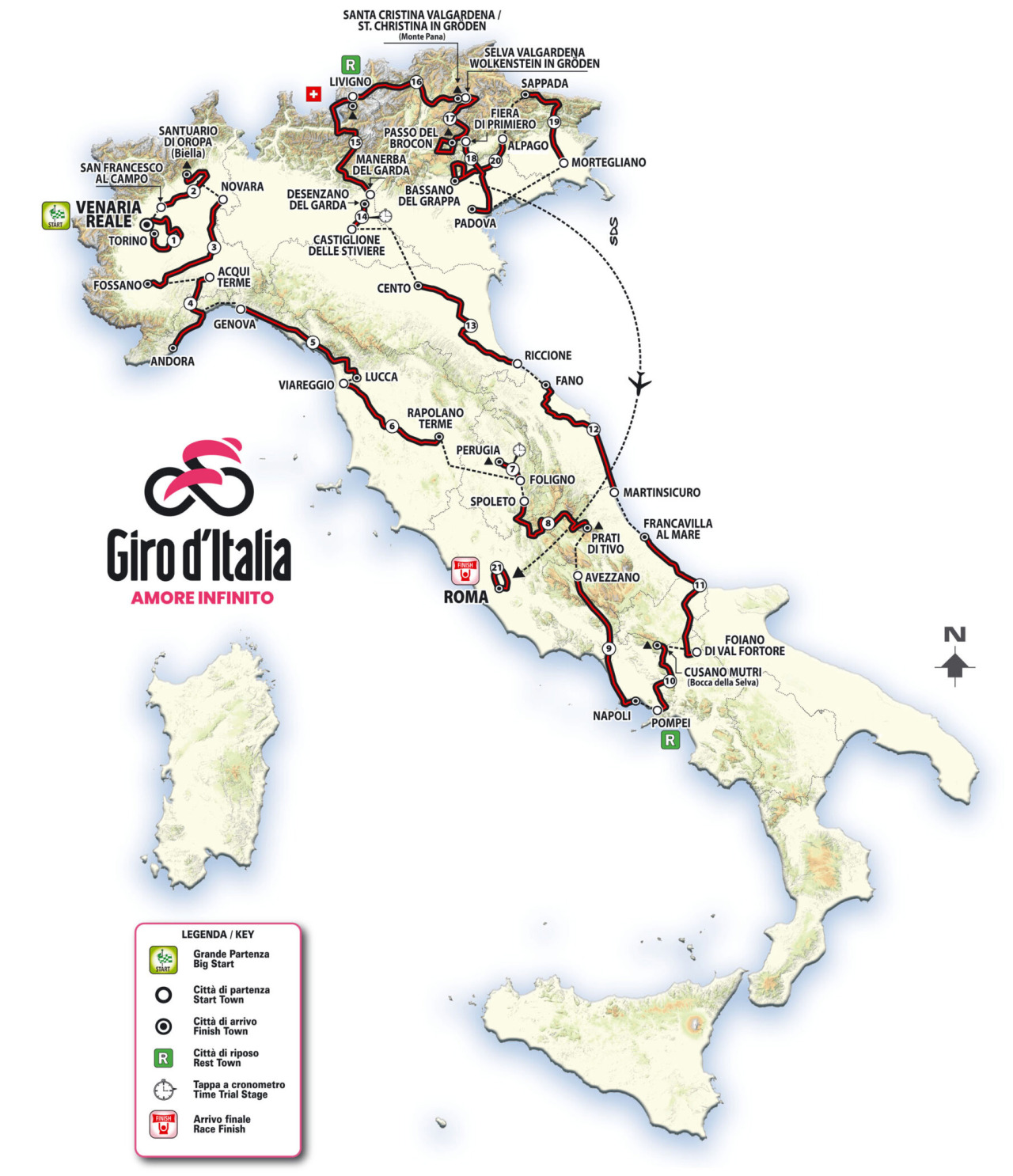
Thanks for the race preview! Maybe the most important thing will be the weather!
It can’t be as bad as last year, although some other editions have been cold and wet too. The long term forecast looks alright, better than last year so hopefully it’s better.
Best summary and descriptions anywhere on the interwebz!
Pundits have noted the route was possibly “softened” to entice Pogacar to add Giro to his TDF ambitions.
But it will also help Geraint Thomas, no?
GT is excellent TTer. Even though it’s unlikely GT would win Giro, and virtually no chance in TDF, it seems plausible GT could podium in both Giro & TDF this year. That would be quite a high note on which to gracefully retire.
A podium in the Giro is possible, especially with the flatter route and the amount of TTkms but is the form good? It wasn’t sparkling going into the race last year but he was playing catch-up after illness, now he’s had a more clear run but not looking sharper… but doesn’t need results until May.
As it’s often been the case in recent years, the Giro gets a very high profile sprinting field, probably deeper and more solid all around than the TDF’s. Besides, many teams, unlike the TDF, bring a serious “sprinting team” focused on maximising their fast man’s options.
I’d say that only Philipsen will be really missed among the bunch sprint specialists, a huge absence indeed, still a single rider and IMHO not yet a proper star (needs more top seasons).
The good news is that, albeit still lacking a point of variety, a very good design for those sprint stages is finally back. For the spectators who happen to enjoy this specialty, many stages will be worth watching half an hour or so before the still hugely probable bunch sprint. At least, that’s true for the first four of those sprint stages, whereas the last four are flatter (Roma will be entertaining all the same). Couldn’t they mix up things a little more? Whatever, no need to become so picky.
Of course, the reason why the sprinting field looks thicker at the Giro is sadly that many teams really put all all all their eggs into the TDF basket GC-wise (BORA being the most shocking example).
Also no Champs-Elysses stage this year in the TDF because of the Olympics which I think changed the calculation for some teams.
A lot of sprints but with some hills and surprises, Tim Merlier won’t have it easy. But also a bit repetitive, would like a couple more uphill finishes for the breakaways and puncheurs, the kind that ride into “centro storico” medieval town square… but logistics are making this hard.
That’s what I was referring to about at least the first 4 sprint stages (out of 8). As I wrote, I’d have appreciated more variety, but it’s still an improvement (going back to the past) in a course which got worse under pretty much every other aspect or so.
I still hope the short uphill action for Classics men and/or breakaway heroes you feel we might be missing as a finale will be even more lively on the last small climbs in stages like Rapolano (too easy for a GC threat… or treat?), Naples, Fano, Sappada, precisely because the stage doesn’t end there, so the better climbers will need to fire their all. Otherwise, who knows, even Monte Pana might work.
What’s sure is that most of those occasions are far from the degree of effort which might involve GC athletes in a battle, which instead made for great finales in the past. But I suspect that Vegni was asked to avoid precisely that, in order to have as many stages as possible where the leader can “sleep” with no worries at all until the finish line.
I found myself thinking about the “a sprint stage” vs. the hilltop finishes of Giri past too. – is it a sprinter today? Does it fit Ulissi or is it more for Sagan? Will they ride it hard and make it a GC finish?
Exciting, unpredictable and usually a scenic approach into known, or lesser known, town. Think Perugia, Agrigento, Asolo, Osimo and many more.
Is this mostly about logistics, as you suggest, or is there more to this? Smaller (hilltop) towns = smaller budets? Politicians less willing to cooperate/close towns? Safety? Desire to attract sprinters? A different philosophy from the race organisers?
That Grappa descent will be interesting, especially if the standings are tight and the intergiro time bonuses working properly. Is it too long to consider the top almost a flamme rouge with limited options of catching up to the riders first over the top?
Is the Stelvio open? I thought I read it was still snowed in as recently as last week.
Definitely still covered in snow!
Yes, it’s closed. It’s normal as the high Alpine passes typically open in May, many have almost a fixed calendar with this pass opening on the Nth day of May and another on N+1 etc.
As ever the risk is not the snow there today, it’s if a cold front comes in the day before the stage or on the day itself and dumps snow, then we get Plan B etc.
Given the Stelvio is near the start of stage 16 rather than near the end, would it actually make a significant difference in the overall result if it were to have to be omitted?
Not necessarily so, but it’s a literally giant space of opportunities to be explored in case some teams wanted to make things really really different.
Let’s put it this way… With the Stelvio in, it might be by far one of the most dangerous stages for Pogačar in the whole race. Without it, it’s a very favourable stage where he’d easily gain more time in GC with the least effort.
And it’s also a big draw for the audience. A flat route up the valley won’t have people tuning in as much as the Stelvio, the name itself is a draw but so will be the racing with the mountains jersey at stake and more.
Thank you for your reply. Much as I’d love to see some teams really going for it & attacking on the Stelvio, I suspect that may not be a realistic hope.
After seeing the early 2000’s lower than otherwise climbing numbers i wondered if these years had different types of winners (which is not a bad thing variety being the spice of life). So i went down the rabbit hole of the winners. I guessing it did becuase the winners seem to have less climbing pedigree than since.
Simoni won in 2001 and 3 and i don’t really recall the rider as its before my time following the sport but i did find his wikipedia (a known source of not always reliable info) page a little ironic/humorous especially considering what we know now about this time. 1998 it says was so poor for results that he briefly quit cycling but came back in 1999 and podiumed the giro which is quite the comeback, must have trained hard. But he was critised in some press for claiming this 3rd place because it was due to the disqualification of pantini who was presumably unjustly removed from the race.
In 2002 he was suspended for a cocaine positive but was this was later rescinded because it was found that the cocaine came from candles that his aunt bought from Peru. Which ranks with the Van Der Pol father in law Pigeon pie for “bad Luck” in things which give you a positive doping result. I guess its lucky that the Italian cycling federation had the ability to determine that candles from Peru are cocaine infested and if you can inhale so much if you burn them you will test positive.
Sometimes in cycling the history is more interesting than stuff you make up.
Candies, not candles.
Strong pure climber, probably one of the best in this specialty in his decade. Pretty much focussed on the national calendar although with some solid mountain stage victories abroad.
Stubborn, quarrelsome, outspoken, he was an Heras of sort although with a slightly better “weighed” palmarés as he never accepted to work as a gregario.
Way cleaner than Heras, too, even if also a bit less talented, probably.
He was part of a *relatively* cleaner generation of riders as in Italy for a handful of years the police and some public prosecutors were pushing hard against doping (even against the most powerful football team, Juventus).
He famously attacked with a long range raid along with rival Garzelli his teammate Cunego while the latter was in maglia rosa in 2004 at the end of three weeks of tension as the team couldn’t establish a clear hierarchy (Cunego was the fresh new young revelation soon loved by the general public, Simoni the “official” leader). Cunego got that Giro.
Another famous anecdote is when he told the press right after the finish line that Ivan Basso (another rival he really hated) had tried to buy a stage victory from him. Basso wanted to win the stage (the last before the final sprint in Milan…but his 3rd stage win, already!) to dedicate the victory to his newborn baby, Santiago; he already had the photo with him, but, as he was über-dominating the Giro, “unwritten rules” would suggest that in the case of a two-men arrival, he should graciously leave the stage to Simoni, so, according to the latter, he apparently offered him money or some other agreement of sort, which Simoni refused, just to be outpowered and left behind on the gentle Aprica slopes. That was the (in)famous Basso 2006 vintage edition.
That 2006 Giro was a true feat by Simoni, making the podium at 35, behind (well, 12 minutes behind…) two athletes fully powered by Fuentes. A landmark in 2-speed cycling.
In 2005 he was ultimately denied GC victory by less than 30″ because of “agreements” across different teams which favoured Savoldelli, then at Discovery with barely any support from his team, but besides having a good strategic mind, “il Falco” also got help by Lotto and Phonak riders pulling for him for no clear reason.
Re-reading the above, “he was an Heras of sort” refers to the technical qualities, not the character, which I was describing just before, and which was hugely different from Heras’.
Looking back at Wikipedia I see it was candies and I misread. Its only just slightly less unusual than candles. Not sure how this ranks compared to pigeon pie though.
Thanks for the backdrop on the rider. It was before my cycling time so I know little about Simoni.
Looking forward to this different route though to see if it makes the race different.
Not quite unusual, really. Just Google «hoja de coca caramelo» and you’ll easily discover a range of commercial brands not only in Perù but also in Bolivia etc. As most products, you can get an industrial version or the «artesanal» ones.
Also the Van der Poel “I tested positive because of a pigeon pie from my father in law” is an internet classic. Why? Because Van der Poel was not married in 1983. In fact he’d only meet his future wife Corinne Poulidor for the first time in 1987 and they married in 1989. Yet the story is on Wikipedia and elsewhere.
Still baffled by this story – the substance van der Poel tested for is stated to have been strychnine. Why on earth would anyone take this, (or give it to pigeons), indeed why is it a banned substance? Does it have some performance-enhancing properties, as well as being “a highly toxic, colorless, bitter, crystalline alkaloid”!
Considered to be a stimulant. Draw a line from Hicks to Izzat and you’ll find Adrie somewhere in between.
Well, the alleged pigeon was an old racing pigeon, so the implication was it was the (former) pigeon which had been doped before being served up to Adri.
Exactly how strychnine helps, I don’t know either. 😉
It was thought to be a stimulant back in the day. Many of the earliest doping cases involved strychnine.
It wasn’t from Poulidor. The pigeon was from Hennie Kuiper, his mentor.
I’d post the link, but as far as I know you have the site setup to block comments with URIs in them. E.g., see the retrospective piece on Adri “Een mafketel met karakter in z’n donder” in the NRC Handelsblad.
Sorry, read it wrong. He’d developed a taste for (or been advised to eat) pigeon meat by Hennie Kuiper, who’d given him the recipe.
So he liked eating pigeons. And old racing pigeons are the easiest source. The implication is he sourced it himself.
That it was a racing pigeon I’m sure I’ve read somewhere in a dutch article somewhere, but I can’t find it back.
You can post a URL but multiple ones seem to trip the spam filter.
The version on Wikipedia needs editing, this probably the root of the wrong story.
Another account, from a journalist who has actually followed Dutch cycling a good while and has interviewed Adri (and been to his home and met his little boys, as they were then), Fred van Slagteren, writes in a Revu.nl piece “Mathieu van der Poel: goeie genen, goeie benen” that Adri eat the troublesome pigeon at a restaurant.
That’s in a section entitled “Romance met Karin Janssen”, which would mean if there was any connection between the doped up pigeon and a former star of cycling, it would have been Jan Janssen, not Poulidor.
Funnily enough, googling for Karin Janssen and Adri to try get sources, leads me to… Inrng! See inrng dot com slash 2022 slash 09 slash wednesday dash shorts dash 24 😉 for more delicious pigeon content. 😉
The easy route might be an issue for Pogi in (the only) case this becomes a little complicated for him, barring misfortune, of course (I mean a Basso 2005 / Kruijswijk 2016 situation or so).
In fact, I can see him in a tight spot only if some L’Aquila thing takes shape, and interestingly enough, besides any unknown factors (by definition the most dangerous ones in such a scenario), many of his – relatively – strongest rivals might fancy a chance in a fuga bidone.
O’Connor would be just perfect, his team is in excellent overall shape and he’s both capable to go the distance *and* to keep strong after such an effort in order not to lose excessive amounts of time the day after (besides his 2021 TDF feats, I remember him performing impressively in two back to back long range breaks at the 2020 Giro). His main problem will be the absence of other serious rivals… which will make of him a marked man of sort!
In that sense, Bardet and Juanpe López, both in form, the latter also in a good season “teamwise”, could be granted a little more freedom, just as Woods.
Obviously, as in L’Aquila, the premise is that each and every other team colludes against UAE not helping to chase a strong break under hard conditions. Some sort of surprise effect is also needed, because if the break looks too good too soon, Pogi would simply jump on board.
If one thinks about it, the best rivals of Pogi are actually mainly big-break men… Arensman was such when he got his best results in 2022, then the team chose a different route for him, same on a lesser level for Storer and Hugh Carthy. But think also old guns and once gregarios like Poels or Caruso who grabbed their best results in recent years thanks to impressive breakaways.
I’d even say that I’d struggle to name several possible GC rivals who are *not* breakaway specialists of sort. Thomas, surely, then Uijtdebroeks, maybe Dani Felipe whom I see rather as a “stepped up gregario”… then?
I’m not speaking of one or more of the above break-men getting a standard bonus of 5 minutes, I’m thinking of a situation going out of control because the not-that-strong UAE is left totally alone facing a hard day against a powerful break who hence arrives well over the 10 minutes mark. The “mass destruction” days to get that time back would be just a couple, stage 15 and 20, and maybe (just maybe) even 17.
OTOH it must also be said that in a course probably co-designed by Gianetti, there aren’t really many breakaway stages which can become exagerately wild or hard to control, due to the large flat sections included by many of them and their generally modest length (hence the need of some help by the weather).
The other recent case of the by-far-strongest rider coming under huge pressure is 2015, Contador vs. Astana. It would indeed be the most similar situation… if we had an Astana team at the start, not only in terms of physical capabilities, but also in terms of attitude and strategical vision.
2019 would be another interesting case study, but I can’t see Pogi getting locked in any Mexican stand-off of sort with a powerful rival (who?) as it happened with Nibali and Rogla while Carapaz was riding minutes away with nobody going all-in behind him.
Thanks for a great preview. Two local insights from me (in Lucca):
1) for the finish into Lucca, 3km to go for one km is a very rough narrow cobbled street (slightly downhill). It seems crazy to send riders down Via Borgo Giannotti – sadly, I think crashes will be inevitable.
2) I saw Alberto Bettiol smashing it up Monte Serra today. He’ll be targeting the Tuscany white roads stage, I am sure.
Thanks again!
2) won’t be an issue – I see Bettiol isn’t in the team. Perhaps saving himself for the Tour, no odd.
I can see 9 possible Pogačar stage wins: 1, 2, 8, 10, 15, 16, 17, 19, 20
I think I can say, barring some unforeseen incident, that he’ll have at least 4 wins out of those 9 here at the Giro.
2 problems I can see for UAE & Pogacar. First, Pogacar’s enthusiasm to race after a quiet Spring will have to be tempered otherwise he could burn himself out.Second, UAE’s team strength will apparently not be their best so a if a couple of guys go home early (ill or crashes) then chasing breakaways could become difficult.
It’s interesting that it seems to be general knowledge that this route is easier than normal in order to allow Pogacar to target a Giro-Tour double. But how does that come about? Presumably the full route takes most of the 12 months between editions to fully sort out? Its not like Pogacar can ring RCS in December and say he fancies a go as long as they ease it up a bit. So who has approached who?Have RCS contracted him since June? Or has his management approached RCS? Just wondering, not that I expect anyone to know!
Also, why can’t we have similar arrangements in one day races?! Instead of race organisers constantly throwing extra hills into their races. Adrie should put his pigeon pie down for 5 minutes and ring RCS about Lombardia..!
For example, they added another hill at the end of stage 1 just recently. The start and finish town are fixed, but I’m guessing they can vary a course quite a bit.
That’s something they typically do, often with the excuse of some road works or whatever, but more often than not it’s really deliberate to play mind games with the teams (as in, luring in sprinters just to later make the finales more complicated, or opening up the dream of a first maglia rosa to a different set of riders whom you might want to be more present in the official startlist etc.)
I’d add that while it might look “not professional enough”, if properly done it’s actually an astute way (which often works) to add some surprise effect and shake things up.
As I commented months ago, just after the first presentation of the route but before Pogi was announced, several stages really looked like they had been modified when compared to what could be expected with those starting and finishing places, or even comparing to the “typical profile” you’d expect for that kind of stage. An AI might do a decent job to highlight this sort of situations. They really look like something has been cut out. Plus, and a smoking gun in a sense, some eagle eye noticed back then that on the map some stages had a different route than what the profile showed. They probably started designing it well before one year ago (as for start and finish points), but then started talking with the team in order to explore possibilities about Pogi. They probably negotiated several aspects and were already more than sure he was going to include the Giro in his programme when the (nearly) definitive course was presented. The news were out later in order to distribute impact through the off season. No doubt that it was RCS which addressed Pogi, or more probably the Italian-speaking UAE staff, remember also how relevant is Colnago (impressive business growth figures for them) for the whole project.
The subject of Lombardia has been long debated among fans and specialists. The course partly depends on local committees and institutions which, for example, in Bergamo would really fancy a harder course more focussed on the very urban finale. Luckily in this case RCS said “no”. In fact, it’s a shame that Lombardia’s course gets public a mere handful of days before the race. Hard to make a serious programme for most athletes (for some, including Pogi, it’s really the same). I believe that it’s legitimate for it to be “the climbers’ Monument”, but at the same time I think that it should and could be seriously worked on in terms of course in order to open an (however hard to grasp) alternative option for a different kind of athlete (who can climb a bit, of course).
Obvious as it is, I’d say that the race can adapt a little (especially one of historically changing nature as Lombardia is), but not to the point that the athlete doesn’t also need to adapt – and a lot more, I’d even say. Otherwise the whole merit of it would be lost. With a different and yet traditional finale at the very foot of the Poggio, Gilbert would have won a couple of Sanremos, but, alas, cycling is about facing shifting conditions and finding your place all the same.
However, until MvdP doesn’t win a Liège, surely closer to his set of skills than a Lombardia, I think that he himself won’t target Lombardia, which might clash with other priorities of him as a cross-disciplinary athlete. And, all that said, the real obstacle for a Strive for 5 Mathieu project nowadays is a person (or 2 or 3), not really any climb.
I’d go with a lot of that. There might also have been an angle of RCS wanting to dial back the Giro anyway and telling Pogačar’s team that this year of all years would suit so they could sit down for talks (including the appearance fee) but there is always scope to adjust the route too.
All this focus on the Five Monuments for Pogačar and Van der Poel but in Merckx’s day Liège-Bastogne-Liège was much flatter than it was today, perhaps Van der Poel could win on the 1970 route. Paris-Roubaix has a lot more pavé than the 1970s today too. Similarly Lombardia of old had a different route with a Milan start etc, still plenty of climbing. Anyway the stat/anecdote that X and Y rider can win races ABCDE today shouldn’t have an equal meaning across time as each race is very different and a product of their time, eg today’s TV age requires action.
You’re right of course, still the fact that it was so difficult to make it although from relatively years top riders were tackling them as top races (not in a “Strive for 5” perspective, of course) suggests that it was no easy feat anyway. Plus, if you check athletes in “modern” era (decades ago, anyway) you often notice that Monuments “come in bundle together” more or less as you might expect. Despite exceptions like Tafi 😉
Lombardia might end in Milano or Monza but it included Valcava from the hard side hence you really needed to be able to climb even back then because it made a decisive selection even 100 km from the line. Maybe it was not the same aspect we notice today (optimal effort curve, essentially), but in a slightly further past maybe it was more about knowing the roads.
( Bends on a descent are drawn differently in Italy and Spain, just to speak out of personal experience, and it makes a difference. )
I would debate (as I have done for probably 10 years) whether putting extra hills in a one day race creates ‘action’. Do the hills after La Redoute create action, or allow Pogacar/Evenepoel/Rider X to increase their gap/underline their superiority and win by more? Would a flatter run in not create ‘action’ by giving the bunch (including the Vans) more chance of a catch, thus creating more suspense and an actual reason to keep the TV on?
Lombardia should obviously always contain hills but they don’t necessarily all have to be packed into the finale, or be full on alpine passes. Short and sharp is where the action is at, especially with the current crop of riders. Too long and Pogacar always wins and the rest don’t even turn up.
Anyway, thanks for the insight on the Pogacar/Giro match up.
I agree with you, more or less, hence the adverb “luckily” I used above even if as a local I’d love to see the pros on Maresana or Ripa di San Vigilio. A serious climb further away then a longer hilly finale with flattish strategic sections. Some of the old Como routes were nearly perfect. A lot anyway is about subtle shades of gray and the specific athletes. Pogi is made for Lombardia as MvdP is for the Ronde, pulling the route away from their skills nearly equals denting its identity. And Pogi found the way to get his Ronde all the same…
My favourite finish is the Mur de Huy but this year I was startled to notice the condition of the road surface … it makes this show piece shabby.
Given that it is only 1.2 km you wouldn’t think it would be that hard to keep it looking sleek.
A piss poor route and the more you look at it, the worse it gets. I miss the times of Zomegnan. 10 possible stages for sprinters? What is this? The Giro or Eneco Tour?
That weird moment when gross provocation looks dangerously akin to sheer common sense!
I am not provoking just stating the obvious:) It follows the pattern of recent years with poorly designed Giro routes which is a travesty given the terrain Italy offers. You mentioned earlier how exciting the 2015 edition was where Astana put Contador to the sword but the route then was just brilliant. Ever since it is a gradual decline and this year just takes the cake. I am frustrated because the Giro was my favorite race of the year. now you just cannot be bothered to watch half of the stages.
I partly agree, there’s sure a general decline of sort, not fully depending on route design, both because of issues with local economy and, simply enough, because sometimes change is needed to gain back a fresh approach with new (or old) ideas, just as it happened with Castellano who went from great to meh.
And even Zomegnan’s wasn’t exactly a golden age, although it was a necessary and important premise for the Giro growth which followed: if you check his routes one by one you could easily find several flaws. I’d even say that Vegni’s were better in overall terms. Zomegnan, for sure, could forge a fenomenal change in mentality when the Giro was at its lowest or so.
2013-2016 was probably a prime of sort *in terms of course design* (just on paper, because obviously a good route is a fine starting point to have a good race but you can get a decent race with a mediocre route design as in 2017 or 2018 or a modest race with a good route as in 2012 or 2020).
Yet, personally I believe that 2019-2021 were also excellent routes, whereas 2022 had too many critical flaws. 2023 wasn’t bad as such but the arm wrestling with different powers in the sport made it terrible. All in all, the Vegni decade was steadily good, even more so if you look more closely and observe that routes which were less convincing always depended on the need to get some top name on the startlist hence giving ’em what they wanted just as with Pogi now, Dumoulin in 2017, then also Froome. 2022 is really the main and only exception.
Vegni is a good director under many respects, but I’d say a couple of his weaknesses are proving very detrimental to the race. First, he’s awful when a plan B is needed (for example, besides the obvious question of stage re-routing due to bad weather… what if one or two of the stars you count on for the Giro can’t start or finish it?). Secondly, what once was a virtue, especially when compared to Zomegnan, i.e., an open listening attitude of sort, now became exaggerate and it’s being exploited by third parties to harm the race. Bad weather again being a source of problems well out of proportion.
So what is this “intergiro” competition exactly?
If I understand the blog post correctly, this is a /separate/ competition from the normal point competition? And it has both points /and/ time bonuses? But the time bonuses go to GC?
WTF? 🙂
Exactly. Waiting for the race rulebook which should be out very soon. The old Intergiro was a points competition based only on the intermediate sprints, this looks more mixed and how the (I) works with the points competition and the other (S) points on the profiles remains to be seen.
I think it’s already out, not sure if I’m able to link it.
Maybe here…
https://drive.google.com/drive/folders/1Ovg7JxrlAvzC_2B0bTAWAPd44crtmJLP
(Please delete the comment if not adequate)
That’s the Garibaldi roadbook. Useful if people want a PDF with all the maps and info but oddly they produce a separate document with all the rules and regulations and it usually comes out a few days later.
Not sure if you’ve covered this, but it seems that
• intermediate sprints 1 ans 2 (intergiro) give points towards the points jersey
• intermediate sprints 2 (intergiro) and 3 give time towards GC
• sprints 1 and 3 give points towards the intermediate sprints competition
• sprint 2 is its own competition
Or, to summarise differently
• sprint 1 = points
• sprint 2 = points and time
• sprint 3 = time
This could be very wrong, though
That makes sense, will copy it to the rules part as the summary is useful.
I seem to remember that stage 1 did not finish originally after going for a trip up in the hills, which looking at the map and the descent down some twisty roads to the finish, is a recipe for disaster, especially if it rains. I hope common sense will prevail in the peloton, but I fear the chance of being in the maglia rosa (even for just one day) might over come otherwise calmer minds.